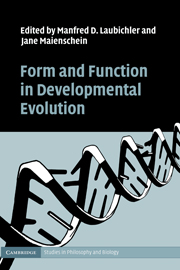Book contents
- Frontmatter
- Contents
- List of figures
- List of tables
- List of contributors
- List of journal abbreviations
- 1 Introduction
- 2 Form and function in Evo Devo: historical and conceptual reflections
- 3 Deducing plant function from organic form: challenges and pitfalls
- 4 Evolution in the light of embryos: seeking the origins of novelties in ontogeny
- 5 A focus on both form and function in examining selection versus constraint
- 6 Innovation and diversity in functional morphology
- 7 The developmental evolution of avian digit homology: an update
- 8 Functional analysis and character transformation
- 9 The nature of constraints
- 10 Toward a mechanistic Evo Devo
- Index
- References
9 - The nature of constraints
Published online by Cambridge University Press: 28 June 2009
- Frontmatter
- Contents
- List of figures
- List of tables
- List of contributors
- List of journal abbreviations
- 1 Introduction
- 2 Form and function in Evo Devo: historical and conceptual reflections
- 3 Deducing plant function from organic form: challenges and pitfalls
- 4 Evolution in the light of embryos: seeking the origins of novelties in ontogeny
- 5 A focus on both form and function in examining selection versus constraint
- 6 Innovation and diversity in functional morphology
- 7 The developmental evolution of avian digit homology: an update
- 8 Functional analysis and character transformation
- 9 The nature of constraints
- 10 Toward a mechanistic Evo Devo
- Index
- References
Summary
INTRODUCTION
One of the most striking features of organisms is how well they are suited to live and reproduce in their environments. In general, we are impressed by the level of engineering necessary for an eye to see, or a bird to fly, or the potency of a snake's venom. And the closer one looks, the more marvels one finds, from the manifold adaptive capacities of the liver to the mechanisms of DNA proofreading. With his theory of evolution by natural selection, Charles Darwin provided the naturalistic explanation for such design that is now fundamental to the science of biology.
Although the theory of natural selection is considered Darwin's greatest contribution, his stated primary goal in publishing the Origin of Species was to argue that different species were of common descent.
Although much remains obscure, and will long remain obscure, I can entertain no doubt, after the most deliberate study and dispassionate judgment of which I am capable, that the view which most naturalists entertain, and which I formerly entertained – namely, that each species has been independently created – is erroneous. I am fully convinced that species are not immutable; but that those belonging to what are called the same genera are lineal descendants of some other and generally extinct species, in the same manner as the acknowledged varieties of any one species are the descendants of that species. Furthermore, I am convinced that Natural Selection has been the main but not exclusive means of modification.
(Darwin 1859: 6)- Type
- Chapter
- Information
- Form and Function in Developmental Evolution , pp. 201 - 212Publisher: Cambridge University PressPrint publication year: 2009
References
- 1
- Cited by



